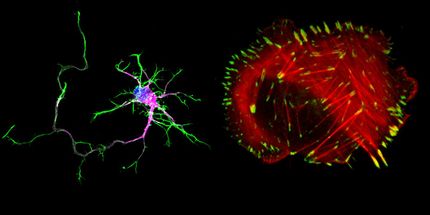From a set of formulas to visible changes in liver cancer
A positive evaluation by a European Union brain-trust set the course for the new research network CancerSys. The consortium addresses itself to the systems biology investigation of liver cancer and is expected to begin work early in 2009. CancerSys evolved from HepatoSys, the Systems Biology Competence Network founded in 2004 for the investigation of liver cells, and will expand its work to an international level of collaboration.
Systems Biology is a young field with the overall aim of creating a holistic picture of dynamic life processes with regard to all levels - from the genome via the proteome and the organisation of the cell organelles all the way to the complete cell or even an entire organism. In doing so, Systems Biology takes into consideration the dynamic interplay of the components involved. In order to achieve this high aspiration, Systems Biology combines quantitative methods used in molecular biology with knowledge gathered in mathematics, informatics and systems science.
CancerSys is aiming at two particular signal paths known to play a role in the development of cancer if they get out of control, namely, the beta-catenin- and the ras-signal paths. Both regulate the reproduction (proliferation) of liver cells and have an influence on their gene activity. The beta-catenin-path is particularly relevant in the center of the lobe of the liver whereas the ras-signals are dominant in the periportal area, i.e. close to the portal vein which is the gateway for blood entering the liver.
The objective of the CancerSys consortium is to construct dynamic models of these two signal paths and their interaction and to then integrate them into a three-dimensional simulation of the liver. "We created mathematical models on the basis of quantitative molecular- and cell-biological tests and then built a bridge from this set of formulas to the visible changes caused by the cancerous process in the liver", CancerSys coordinator Prof. Dr. Jan Hengstler of the University of Dortmund said, in explaining their research objective. By means of this hitherto unique methodical approach, it is possible to graphically reconstruct which consequences a change - i.e. through gene mutations, viral diseases or toxic substances such as alcohol and certain medications - involves in the network of signal paths and can thus contribute to the development of cancer. Impressive first simulations can be viewed at http://inria.livertumor.hoehme.com.
The CancerSys research project was given the highest possible rating by the European Union brain-trust and is expected to take up work early in 2009. In the first instance, nine project partners with their research groups are participating. Four of them will work experimentally, four will work theoretically and one will work in both modes.
Other news from the department science

Get the life science industry in your inbox
By submitting this form you agree that LUMITOS AG will send you the newsletter(s) selected above by email. Your data will not be passed on to third parties. Your data will be stored and processed in accordance with our data protection regulations. LUMITOS may contact you by email for the purpose of advertising or market and opinion surveys. You can revoke your consent at any time without giving reasons to LUMITOS AG, Ernst-Augustin-Str. 2, 12489 Berlin, Germany or by e-mail at revoke@lumitos.com with effect for the future. In addition, each email contains a link to unsubscribe from the corresponding newsletter.


















































